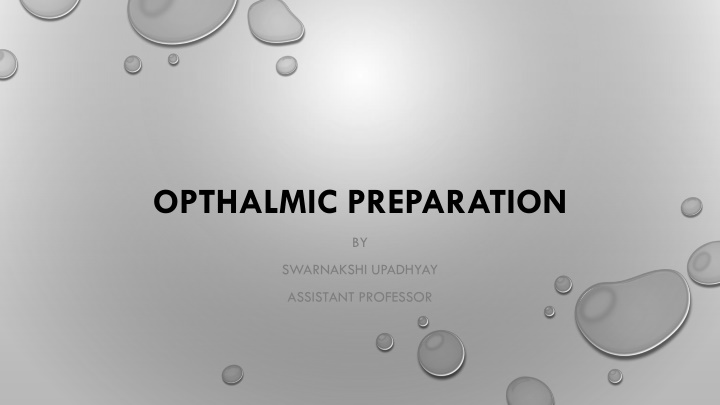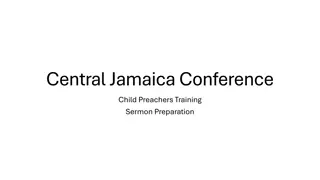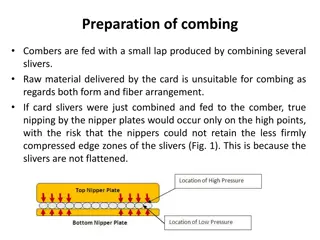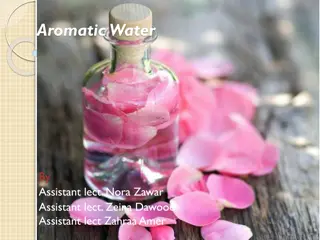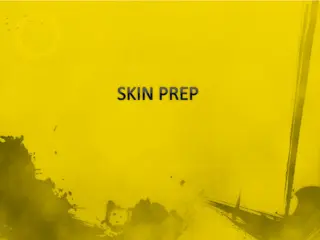OPTHALMIC PREPARATION
Ophthalmic preparations are essential for eye health, and their formulation requires careful consideration of factors like tonicity, pH adjustment, viscosity-imparting agents, stabilizers, antioxidants, surfactants, and preservatives. The goal is to ensure stability, bioavailability, and efficacy while minimizing irritation and maintaining sterility. Various ingredients and techniques are used to achieve optimal drug delivery and treatment outcomes in ophthalmic care.
Download Presentation

Please find below an Image/Link to download the presentation.
The content on the website is provided AS IS for your information and personal use only. It may not be sold, licensed, or shared on other websites without obtaining consent from the author.If you encounter any issues during the download, it is possible that the publisher has removed the file from their server.
You are allowed to download the files provided on this website for personal or commercial use, subject to the condition that they are used lawfully. All files are the property of their respective owners.
The content on the website is provided AS IS for your information and personal use only. It may not be sold, licensed, or shared on other websites without obtaining consent from the author.
E N D
Presentation Transcript
OPTHALMIC PREPARATION BY SWARNAKSHI UPADHYAY ASSISTANT PROFESSOR
INTRODUCTION Ophthalmic preparations (eye preparations) are sterile, liquid, semisolid, or solid preparations that may contain one or more active pharmaceutical ingredient(s) intended for application to the conjunctiva, the conjunctival sac or the eyelids. The choice of base and any excipients used for the preparation of ophthalmic preparations must be proven through product development studies not to affect adversely either the stability of the final product or the availability of the active ingredients at the site of action. The most commonly employed ophthalmic dosage forms are solutions, suspensions, and ointments. but these preparations when instilled into the eye are rapidly drained away from the ocular cavity due to tear flow and lachrymal nasal drainage. Ideal ophthalmic drug delivery must be able to sustain the drug release and to remain in the vicinity of front of the eye for prolong period. the newest dosage forms for ophthalmic drug delivery are: gels, gelforming solutions, ocular inserts, intravitreal injections and implants.
FORMULATION CONSIDERATIONS TONICITY AND TONICITY-ADJUSTING AGENTS: The tonicity of aopthalmic solution should be adjust correctly(urge a osmotic pressure equal to that of tear fluids, generaly agreed to be equal to 0.9% NaCl) a range of 0.5-2.0% NaCl equivalency does not cause a marked pain and range of about 0.2-0.7% sholud be acceptable for most persons. Common tonicity adjusting ingridient are:nacl, kcl, buffer salt, dextrose, glycerine, propylene glycol and mannitol. pH ADJUSTMENT AND BUFFERS: pH adjustment is very important as pH affects: To render the formulation more stable The comfort, safety and activity of the product. eye irritation increase in tear fluid secretion rapid loss of medication To enhance aqueous solubility of the drug. To enhance the drug bioavailability To maximize preservative efficacy ideally every product buffered to a pH of 7.4(the normal physiological pH of tear fluid) if buffers are required, their capacity is controlled to be as low as possible. To enable the tears to bring the pH of the eye back to the physiological range To avoid effect of buffers on tonicity. Examples of buffer vehicles used:-boric acid vehicle: pH of slightly below 5,isotonic phosphate vehicle: pH ranges from 5.9 -8.
VISCOSITY-IMPARTING AGENTS: Polyvinyl alcohol, methylcellulose, hydroxyl propyl methylcellulose, hydroxylethylcellulose and carbomers are generally used in parentral preparation as viscosity imparting agent. they increase the ocular contact time thereby they decrease the drainage rate, increase the mucoadhessiveness and increase drug bioavilability. STABILIZERS & ANTIOXIDANTS: Stabilizers are the ingredients, which makes the preparation to decrease the rate of decomposition of active ingredient. antioxidants are principle stabilizers added to some opthalmic preparation, primarily those containing epinephrine, and other oxidizable drugs.example: sodium bisulphite or metabisulphite are used in concentration up to 0.3% in epinephrine hydrochloride and bitartrate solution. SURFACTANTS: The order of surfactant toxicity is anionic>cationic>>non-ionic. there are several non-ionic surfactant are used in low concentration to add in dispersing steroid in suspensions and to achieve or improve solution clarity. some of the surfactant which are principally used are sorbiton ether esters of oleic acid (polysorbate or tween 20 and 80). PRESERVATIVES: Preservatives are included in multiple-dose eye solutions for maintaining the product sterility during use. preservatives not included in unit-dose package. the use of preservatives is prohibited in ophthalmic products that are used at the of eye surgery because, if sufficient concentration of the preservative is contacted with the corneal endothelium; the cells can become damaged causing clouding of the cornea and possible loss of vision. the most common organism is pseudomonas aeruginosa that grow in the cornea and cause loss of vision. examples: benzalkonium chloride, 0.004% to 0.01%;benzethonium chloride, 0.01%; chlorobutanol,0.5%; phenylmercuric acetate, 0.004%; phenylmercuric nitrite, 0.004%; and,thimerosal, 0.005%to 0.01%.
FORMULATION OF EYE DROPS Ophthalmic solutions are sterile solutions intended for instillation in the eye.in addition to sterility, these dosage forms require the careful consideration of such other pharmaceutical factors as the need for antimicrobial agents, osmolarity, buffering, viscosity, and proper packaging. An eye drop formulation comprises of the following: Active ingredients to produce desired therapeutic effect. Vehicle(aqueous or oily). Inert antimicrobial preservatives to prevent microbial contamination and to maintain sterility. Inert adjuvants for adjusting tonicity, viscosity and ph to increase the stability of active ingredients. Suitable container to maintain the preparation in a stable form and provide protection against contamination during preparation, storage and use. Multi dose eye drops are added with an effective antimicrobial preservative system(a single substance cannot be successfully used as a preservative in ophthalmic solution) that should pass the test for efficacy of antimicrobial preservative. this ensures that the eye drops are sterile and non-contaminated.
FORMULATION OF EYE OINTMENTS Ophthalmic ointments must be sterile. like suspensions, ointments can be more difficult to manufacture in sterile form. they can be terminally sterilized, or, alternatively, they must be manufactured from sterile ingredients in an aseptic environment. filtration through a suitable membrane or dry heat sterilization is often used. The ointment base selected for an ophthalmic ointment must be non-irritating to the eye and must permit the diffusion of the active ingredient throughout the secretions bathing the eye. Ointment bases utilized for ophthalmics have a melting or softening point close to body temperature. Ophthalmic ointments have a longer ocular contact time when compared to many ophthalmic solutions. Ointment base is sterilized by heat and filtered while molten to remove foreign particulate matter. It is then placed into a sterile steam jacketed to maintain the ointment in a molten state and excipients are added. One disadvantage to ophthalmic ointments is the blurred vision that occurs as the ointment base melts and spread across the lens. The bases like; yellow soft paraffin, liquid paraffin and wool fat can be used for the preparation of eye ointment.
FORMULATION OF EYE LOTIONS Eye lotions are undiluted aqueous solutions, applied to an eye bath, which for first aid purposes. it is may allow a large volume of fluid to flow quickly over the eye. It is iso-osmotic to tears, because compared to eye drops, lotions cause much greater dilution of the lachrymal fluid, hence cause discomfort if not adjusted.e.g. sodium chloride (nacl) eye lotion b.p.c. is used to remove foreign substance from the eye. Thus these preparations should be very simple as well as the most common eye lotion consists of sterile normal saline. this preparation demonstrate the requirements of an eye lotion which are: Sterile as well as usually containing no preservative. Isotonic to lachrymal fluid Natural ph Large volume but not greater than 200ml Non-irritant to ocular tissue.
METHODS OF PREPARATION PREPARATION OF THE SOLUTION: The aqueous eye drops vehicle containing suitable preservative, antioxidant , stabilizer, tonicity modifier , viscosity modifier, or buffer should be prepared, and added with the active ingredient and the vehicle to make up the volume. CLARIFICATION: Sintered glass filters or membrane filters having 0.45-1.2 m pore sizes should be used. The clarified solution is either fillied directly into the final containers which are sealed before heat sterilisation or is temporarily filled into a suitable container before filtration. Clarified containers vehicle is used to prepare eye drop suspensions filled into final containers and sealed before sterilisation. STERILISATION: This can be achieved by autoclaving at 115 c temperature for 30 minutes or 121 c temperature for 15 minutes . Filtration into sterile containers through a membrane filter having 0.22 m pore size is also a suitable method for sterililisation. dry heat sterilization at 160 c temperature for 2 hours is best suited for non-aqueous preparations such as liquid paraffin eye drops. After sterilisation, the eye drop containers should be covered with a readily breakable seal to distinguish between opened and unopened containers.
LABELING The label should include: The name of the pharmaceutical product; The name(s) of the active ingredient(s); international nonproprietary names (inn) should be used wherever possible; The concentration(s) of the active ingredient(s) and the amount or the volume of preparation in the container; The batch (lot) number assigned by the manufacturer; The expiry date, the utilization period, and, when required, the date of manufacture; Any special storage conditions or handling precautions that may be necessary; If applicable, the period of use after opening the container; Directions for use, warnings and precautions that may be necessary; The name and address of the manufacturer or the person responsible for placing the product on the market; If applicable, the name(s) and concentration(s) of antimicrobial agent(s) and/or antioxidant(s) incorporated in the preparation; and The statement "this preparation is sterile".
STORAGE Ophthalmic preparations should maintain their integrity throughout their shelf-life when stored at the temperature indicated on the label. Special storage recommendations or limitations are indicated in individual monographs. CONTAINERS Traditionally, ophthalmic liquid products were packed in glass containers fitted with an eye dropper. Today, glass containers have limited use where product stability or compatibility issues exclude the use of flexible plastic containers made of polyethylene or polypropylene. Most liquid ophthalmic products on the market are packaged in plastic containers fitted with nozzles from which, by gentle squeezing, the contents may be delivered as drops.
Plastic containers have several advantages over the glass-dropper combination such as minimizing the risk of the contents being contaminated with microorganisms by the replacement of the dropper which may have become contaminated by touching the infected eye or any other surfaces. also, plastic containers are cheap, light in weight, more robust to handle and easier to use than glass-dropper type containers. Some plastic materials such as polyethylene can absorb some antimicrobial preservatives (e.g. benzalkonium chloride), or some drugs. they may also leach plasticizers into them product, or printing inks from the label can migrate through the plastic into the product. The challenge is to develop a packaging system for preservative-free products that maintains the sterility of the product throughout its shelf-life and during use. Unit-dose systems offer the easiest technical solution to this problem but have the disadvantage of higher cost of manufacture and of not being as compact as a multidose product containing equivalent doses. An alternative approach is to develop a multidose preservative free system. the container is required to be collapsible, and the suck-back of air, which could contain bacteria, has to be avoided. containers are being developed that contain a valve mechanism to achieve this Plastic containers can also be permeable to water vapor and oxygen over prolonged periods of storage. this can lead to gradual loss of liquid product or oxidation of an unstable drug over time. Polyethylene containers are not able to withstand autoclaving and are usually sterilized by ethylene oxide or by irradiation before being filled aseptically with pre-sterilized product. polypropylene containers can be autoclaved, but are not as flexible as polyethylene for eyedropper use. Semi-solid products have been traditionally packed in collapsible tin tubes. metal tubes are a potential source of metal particles in ophthalmic products, and so the tubes have to be cleaned carefully prior to sterilization. Collapsible tubes made from laminates of plastic, aluminum foil and paper are good alternative to tin tubes. laminate tubes fitted with polypropylene caps can be sterilized by autoclaving.
EVALUATION OF OPHTHALMIC PREPARATIONS STERILITY TEST: It is a method carried out to detect confirm absence of any viable form of microbes in product. the method used for sterility tests are A. Direct transfer method B. Membrane filtration method. A. DIRECT TRANSFER METHOD: Open each sample container and with draw the require amount of the sample. Inject one-half of sample in a test tube containing fluid thioglycolate medium (ftm). Inject another half in the test tube containing soyabean-casein digest medium(scm). volume of the medium must be sufficient to promote and expedite microbial growth. adequate mixing between the sample inoculums and the culture medium must take place to maximize interaction and facilitate microbial growth. If the product to be tested contains any anti-microbial agent, using suitable reagent it should be neutralized before the test. B. MEMBRANE FILTRATION METHOD (MF): This method is employed in the following cases: 1. Oil & oily preparations 2. Alcoholic preparations 3. For preparations miscible with or soluble in aqueous or oily solvents. The steps involved in mf sterility test method are I). The filter unit must be properly assembled and sterilized prior to use. II). The contents are transferred to the filter assembly under strict aseptic conditions. III) The membrane is removed aseptically. IV). Membrane is cut in half. IV) One half is place in suitable volume of ftm and another in an equal volume of scm. INTERPRETATION OF RESULTS: I). If there is no visible evidence of microbial growth, it may be interpreted that the sample is without intrinsic contamination and the product complies the test for sterility. II). If microbial growth is found, the product does not complies the test for sterility and the sterility test may be repeated.
CLARITY TEST (PARTICULATE MATTER EVALUATION):- Particulate matter in parenteral solutions has been recognized as an acceptable. since the user could be expected to conclude that the presence of visible dirt would suggest that, the product is of inferior quality. A). In visual method, the entire product should be inspected by human inspectors under good light baffled against reflection into the eye and against black and white background. dark background detects light particles and light background detects dark particles. any container with visible particle if seen is discarded. B) Some other methods of clarity testing can be listed as filtration method, light scattering method, light absorption, light blockage methods, etc... Once the particles are detected, then they are identified by various methods like microscopy,xray powder diffraction, mass microscopy, micro-chemical tests, polarized light microscopy and scanning electron microscopy.
LEAKAGE TEST: This check is carried out for an ophthalmic ointment to assess the intact nature of the ointment tube and its seal. 10 sealed containers are chosen and their exterior surfaces are cleansed. They are horizontally located over absorbent blotting paper in an oven saved at 60 three for eight hours. The check passes if leakage isn't always found from any tube. If leakage is determined the test is repeated with extra 20 tubes. The test passes if not greater than 1 tube indicates leakage out of 30 tubes. PRESENCE OF METAL PARTICLES THIS TEST IS NEEDED ONLY FOR OPHTHALMIC OINTMENTS: The presence of metal particles will irritate the corneal or conjunctiva surface of the eye. It is carried out with the use of 10 ointment tubes. the content from every tube is fully withdrawn onto a clean 60mm diameter petri dish having a flat bottom. The lid is closed and the product is heated at eighty-five degrees celsius for two hours. once the product is melted and dispensed uniformly, it is cooled to room temperature. Remove the lid after solidification. The bottom surface is then examined via an optical microscope at 30 times magnification. The viewing surface has been illuminated using an external light source located at 45 at the top. The bottom surface of the ointment is examined and the amount of particles 50mm or greater is counted using a calibrated eyepiece micrometer. The usp recommends that the number of such particles in 10 tubes must not exceed 50, with not greater than 8 particles in any individual tube.
